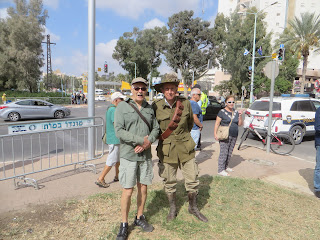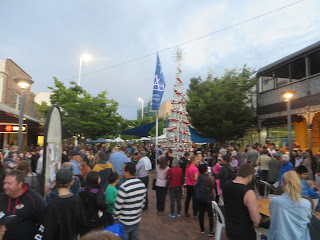I attach below an article from today's Australian Financial Review because it's about a bloke I really admire. Age 15, he was a refugee from Europe detained on Cyprus by the British trying to make his way to Palestine and last week he was knighted by the Queen at Windsor Castle. In between, he reached Australia, became one of the nation's leading businessmen, played a major role in the rise of Australian soccer (and we're headed to the World Cup in Russia next year), and is widely admired.
And I'll never forget the day when he bought me a barramundi dinner at Sydney's Hakoah Club shortly after my arrival in Australia back in the 1970s. I was taken there by Howard Lowe, another Australian businessman who was a good friend of my Uncle Henry - they'd grown up together in Germany before fleeing that nation in the 1930s.
- - - - - - -
From detention to the highest distinction, arise Sir Frank
Jill Margo
When The Queen entered the room attended by the Yeomen of the Guard – the oldest British military corps still in existence – and the orchestra played the national anthem, Sir Frank stood in incredulity and appreciation. Among the roomful of candidates for awards, three were to receive a knighthood. When his turn came, he kneeled on an investiture stool as The Queen placed her sword on one shoulder then the next; he bowed to receive his decoration and congratulations. They chatted a little and he mentioned an event in May 1988 when he had presented the Monarch with the Australian State Coach, a gift from the people of Australia. The Queen remembered and also thanked him for the good he’d done in London.
Sir Frank Lowy AC, chairman of Westfield Corporation, had been appointed a Knight Bachelor in the Birthday Honours List announced in June. According to his citation, he was recommended for his contribution to the UK economy through Westfield and its major investments in the UK. The group opened Europe’s two largest urban shopping centres, Westfield London and Westfield Stratford City, and had submitted an application for a new £1 billion plus retail development in Croydon. In the UK, the Cabinet Office War Rooms, the Imperial War Museum and the Victoria and Albert Museum have all benefited from Sir Frank’s philanthropy. He chose the museum and the war rooms because of his fondness for Churchill and for the way the British treated him in detention.
In that internment camp he’d observed his captors closely. When he looked into their faces, he saw decency. ‘‘We didn’t fear them. They were just doing their job and were not cruel like the Nazis or the Russians. There was no hatred and we were never afraid they would shoot at us. ‘‘And when there was an outbreak of impetigo [a contagious skin infection], they treated us and did so with kindness.’’ After three months, he was on the first boatload of children to be sent to Palestine. On Australia Day in 1952, he arrived in Sydney, to be reunited with the surviving members of his family who had since moved there.
- - - - - - - - - -
That's quite a story.
AS
And I'll never forget the day when he bought me a barramundi dinner at Sydney's Hakoah Club shortly after my arrival in Australia back in the 1970s. I was taken there by Howard Lowe, another Australian businessman who was a good friend of my Uncle Henry - they'd grown up together in Germany before fleeing that nation in the 1930s.
- - - - - - -
From detention to the highest distinction, arise Sir Frank
Jill Margo
At 15, Frank Lowy was behind barbed wire in a British detention camp in Cyprus. He had been arrested trying to make his illegal way from war-torn Europe to British Mandate Palestine. On Friday, at 87, he was at Windsor Castle awaiting his investiture as a knight by Her Majesty, Queen Elizabeth II. As he sat quietly in the castle’s splendid Waterloo Chamber, he thought of the distance travelled. ‘‘I couldn’t quite add two and two together and work out how I got here. But, of course, it was a wonderful feeling to be honoured in this way,’’ he told The Australian Financial Review.
Sir Frank Lowy AC, chairman of Westfield Corporation, had been appointed a Knight Bachelor in the Birthday Honours List announced in June. According to his citation, he was recommended for his contribution to the UK economy through Westfield and its major investments in the UK. The group opened Europe’s two largest urban shopping centres, Westfield London and Westfield Stratford City, and had submitted an application for a new £1 billion plus retail development in Croydon. In the UK, the Cabinet Office War Rooms, the Imperial War Museum and the Victoria and Albert Museum have all benefited from Sir Frank’s philanthropy. He chose the museum and the war rooms because of his fondness for Churchill and for the way the British treated him in detention.
In that internment camp he’d observed his captors closely. When he looked into their faces, he saw decency. ‘‘We didn’t fear them. They were just doing their job and were not cruel like the Nazis or the Russians. There was no hatred and we were never afraid they would shoot at us. ‘‘And when there was an outbreak of impetigo [a contagious skin infection], they treated us and did so with kindness.’’ After three months, he was on the first boatload of children to be sent to Palestine. On Australia Day in 1952, he arrived in Sydney, to be reunited with the surviving members of his family who had since moved there.
- - - - - - - - - -
That's quite a story.
AS






























































